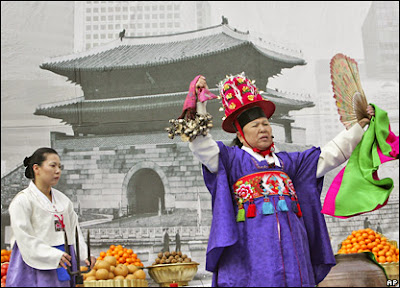Chicken barbecue restaurants are the very popular local cuisine but other gastronomical treats are offered too. However, in the off-season don't expect to find much open. Business thrives in the summertime for families and during the warmer weeks of spring and fall for college students, particularly couples looking for a romantic getaway on a train with an incredible view and a gorgeously landscaped gentle hike up to the waterfall. But during the colder parts of the year until the sheets of ice form on the well-known 67-meter high Kugok pokpo, the village basically shuts down. Once the ice freezes over on the waterfall, however, people once again flock to the place to see the ice and to watch a growing number of climbers chop their way to the top.
I wrote about this waterfall before and introduced how to get there and some of the dynamics formerly used to attract people, namely that people were misled to believe in the early 1990s that the village above the waterfall was an undiscovered village and untainted by tourism. Haha, you can read about that in my Gugok Pokpo - Oct 3 blog entry.
Comparing to the soft green beauty of spring and summer, the winter reveals the rough rocks shaping the mountains and reveals the wells of water springing from those rocks. On the way to the larger waterfall, two smaller waterfalls cascaded in frozen grandeur near the entrance of the park.
Years ago the trail was pretty harsh, but now it's like a paved road with its highly compressed and graded surface. It certainly is easy to walk and isn't slippery. With the leaves gone and only stark tree limbs throwing their skeletal arms in the air, the waterfall peaks out through the trees as one approaches.
I've been here in the winter before but it's been several years. What I'm most amazed at is the increased number of climbers. It's a fact that Koreans are now pursuing some extreme sports very heartily but the number of climbers flocking to the waterfall on this day is significantly more than before. I'm not sure why one group of climbers is pitching a tent but maybe they're having a weekend ice-climbing excursion. Other groups seem to have camping equipment as well, or maybe it's just a lot of climbing equipment in heavy backpacks. The climbing ropes are pretty sizable, even when rolled. Notice in the first picture below one of the climbers blowing a piri, a traditional wooden flute. The music sounded so mysterious and lonely in this setting. Sounds don't seem to carry too well in near the waterfall, but the piri notes floated hauntingly around.
And now to see the climbers in action. Previously I was told that ice climbers climb with two ropes, just on the off-chance that they might pick-ax one and sever their only connection to the above, safety and life itself. All of the climbers today were using only one rope. I'm having to reformulate my understanding of ice climbing. The gentleman to the left in the picture below is top-lining, that is, he's climbing an already threaded rope, the safest way to climb. However, someone has to climb and thread that rope. The guy in the orange coat is also top-lining, while the guy in the green coat is threaded his own line. He has to climb so much more carefully although he is secured by his previous piton hammered in a chock (here's a list of climbing terms).
Looking up close at the last picture makes me really wonder at the quality of the ice. It looks like it has bubbles in it and so the appearance doesn't assure me that I'd feel safe climbing it. Kudos to them for entertaining themselves, and us. The few spectators including myself were quite fascinated by their slow and careful maneuvers to the top.










